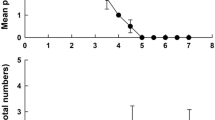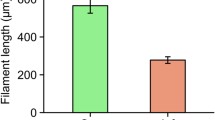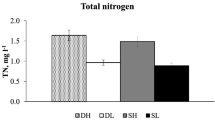Abstract
Understanding responses of parasites to changes in nutrient regimes is necessary for prediction of their role in aquatic ecosystems under global change in nutrient loading. We studied the response of the natural parasite fauna of Daphnia longispina to nutrient enrichment in mesocosms in a small humic lake. We measured the concentrations of inorganic phosphorus and nitrogen in the water, total nutrients in the seston, algal and bacterial biomass, Daphnia population dynamics, Daphnia stoichiometry, Daphnia stable isotope values and the presence and abundance of parasites in treated mesocosms as compared to three control ones. Incorporation of the nutrient enrichment in the food web was seen as increased nutrient concentrations in the epilimnion and as a decrease in carbon:nutrient ratios and δ15N values in Daphnia. Nutrient enrichment did not significantly influence algal, bacterial or Daphnia biomass. One of the four parasite species observed, unidentified small gut parasite, had a higher prevalence (percentage of Daphnia infected) in treated mesocosms, but its intensity (number of parasites per infected host) remained the same among treatments. Our results suggest that the effect of nutrient enrichment on host–parasite dynamics is dependent on complex interactions within food webs and on the epidemiological traits of parasites.





Similar content being viewed by others
References
Arvola, L., K. Salonen, P. Kankaala & A. Lehtovaara, 1992. Vertical distributions of bacteria and algae in a steeply stratified humic lake under high grazing pressure from Daphnia longispina. Hydrobiologia 229: 253–269.
Bennett, E. M., S. R. Carpenter & N. F. Caraco, 2001. Human impact on erodable phosphorus and eutrophication: a global perspective. BioScience 51: 227–234.
Bruno, J. F., L. E. Petes, C. D. Harvell & A. Hettinger, 2003. Nutrient enrichment can increase the severity of coral diseases. Ecology Letters 6: 1056–1061.
Cáceres, C. E., C. J. Knight & S. R. Hall, 2009. Predator–spreaders: predation can enhance parasite success in a planktonic host–parasite system. Ecology 90: 2850–2858.
Decaestecker, E., S. Declerck, L. De Meester & D. Ebert, 2005. Ecological implications of parasites in natural Daphnia populations. Oecologia 144: 382–390.
Duffy, M. A., 2007. Selective predation, parasitism, and trophic cascades in a bluegill–Daphnia–parasite system. Oecologia 153: 453–460.
Ebert, D., 2005. Ecology, Epidemiology and Evolution of Parasitism in Daphnia. National library of Medicine, National Center for Biotechnology Information, Bethesda.
Ebert, D., M. Lipsitch & K. L. Mangin, 2000. The effect of parasites on host population density and extinction: experimental epidemiology with Daphnia and six microparasites. American Naturalist 156: 459–477.
Elser, J. J. & J. Urabe, 1999. The stoichiometry of consumer-driven nutrient recycling: theory, observations, and consequences. Ecology 80: 735–751.
Elser, J. J., M. E. S. Bracken, E. E. Cleland, D. S. Gruner, W. S. Harpole, H. Hillebrand, J. T. Ngai, E. W. Seabloom, J. B. Shurin & J. E. Smith, 2007. Global analysis of nitrogen and phosphorus limitation of primary producers in freshwater, marine, and terrestrial ecosystems. Ecology Letters 10: 1135–1142.
Elser, J. J., T. Andersen, J. S. Baron, A. K. Bergström, M. Jansson, M. Kyle, K. R. Nydick, L. Steger & D. O. Hessen, 2009. Shifts in lake N:P stoichiometry and nutrient limitation driven by atmospheric nitrogen deposition. Science 326: 835–837.
Frost, P. C., D. Ebert & V. H. Smith, 2008. Responses of a bacterial pathogen to phosphorus limitation of its aquatic invertebrate host. Ecology 89: 313–318.
Green, J., 1974. Parasites and epibionts of Cladocera. Transactions of the Zoological Society of London 32: 417–515.
Hall, S. R., C. Becker & C. E. Cáceres, 2007. Parasitic castration: a perspective from a model of dynamic energy budgets. Integrative and Comparative Biology 47: 295–309.
Hall, S. R., C. J. Knight, C. R. Becker, M. A. Duffy, A. J. Tessier & C. E. Cáceres, 2009a. Quality matters: resource quality for hosts and the timing of epidemics. Ecology Letters 12: 118–128.
Hall, S. R., J. L. Simonis, R. M. Nisbet, A. J. Tessier & C. E. Cáceres, 2009b. Resource ecology of virulence in a planktonic host–parasite system: an explanation using dynamic energy budgets. American Naturalist 174: 149–162.
Hall, S. R., R. Smyth, C. R. Becker, M. A. Duffy, C. M. Knight, S. MacIntyre, A. J. Tessier & C. E. Cáceres, 2010. Why are some lakes sicker? Disease ecology, habitat structure and the plankton. BioScience 60: 363–375.
Hall, S. R., C. R. Becker, M. A. Duffy & C. E. Cáceres, 2011. Epidemic size determines population-level effects of fungal parasites on Daphnia hosts. Oecologia 166: 833–842.
Hessen, D. O., 1990. Carbon, nitrogen and phosphorus status in Daphnia at varying food conditions. Journal of Plankton Research 12: 1239–1249.
Hessen, D. O., 2008. Efficiency, energy and stoichiometry in pelagic food webs; reciprocal roles of food quality and food quantity. Freshwater Reviews 1: 43–57.
Hessen, D. O., K. Nygaard, K. Salonen & A. Vähätalo, 1994. The effect of substrate stoichiometry on microbial activity and carbon degradation in humic lakes. Environment International 20: 67–76.
Jansson, M., P. Blomqvist, A. Jonsson & A. K. Bergstrom, 1996. Nutrient limitation of bacterioplankton, autotrophic and mixotrophic phytoplankton, and heterotrophic nanoflagellates in Lake Ortrasket. Limnology and Oceanography 41: 1552–1559.
Jansson, M., A. K. Bergstrom, S. Drakare & P. Blomqvist, 2001. Nutrient limitation of bacterioplankton and phytoplankton in humic lakes in northern Sweden. Freshwater Biology 46: 653–666.
Jansson, M., L. Persson, A. M. De Roos, R. I. Jones & L. J. Tranvik, 2007. Terrestrial carbon and intraspecific size-variation shape lake ecosystems. Trends in Ecology & Evolution 22: 316–322.
Järvinen, M. & K. Salonen, 1998. Influence of changing food web structure on nutrient limitation of phytoplankton in a highly humic lake. Canadian Journal of Fisheries and Aquatic Sciences 55: 2562–2571.
Johnson, P. T. J., J. M. Chase, K. L. Dosch, R. B. Hartson, J. A. Jackson, D. J. Larson, D. R. Sutherland & S. R. Carpenter, 2007. Aquatic eutrophication promotes pathogenic infection in amphibians. Proceedings of the National Academy of Sciences of the United States of America 104: 15781–15786.
Johnson, P. T. J., A. R. Ives, R. C. Lathrop & S. R. Carpenter, 2009. Long-term disease dynamics in lakes: causes and consequences of chytrid infections in Daphnia populations. Ecology 90: 132–144.
Johnson, P. T. J., A. R. Townsend, C. C. Cleveland, P. M. Glibert, R. W. Howarth, V. J. McKenzie, E. Rejmankova & M. H. Ward, 2010. Linking environmental nutrient enrichment and disease emergence in humans and wildlife. Ecological Applications 20: 16–29.
Kankaala, P., 1988. The relative importance of algae and bacteria as food for Daphnia-Longispina (Cladocera) in a polyhumic lake. Freshwater Biology 19: 285–296.
Kankaala, P. & P. Eloranta, 1987. Epizooic ciliates (Vorticella sp.) compete for food with their host Daphnia longispina in a small polyhumic lake. Oecologia 73: 203–206.
Kuuppo-Leinikki, P. & K. Salonen, 1992. Bacterioplankton in a small polyhumic lake with an anoxic hypolimnion. Hydrobiologia 229: 159–168.
Lafferty, K. D., 1997. Environmental parasitology: what can parasites tell us about human impacts on the environment? Parasitology Today 13: 251–255.
Lafferty, K. D. & R. D. Holt, 2003. How should environmental stress affect the population dynamics of disease? Ecology Letters 6: 654–664.
Lafferty, K. D., S. Allesina, M. Arim, C. J. Briggs, G. De Leo, A. P. Dobson, J. A. Dunne, P. T. J. Johnson, A. M. Kuris, D. J. Marcogliese, N. D. Martinez, J. Memmott, P. A. Marquet, J. P. McLaughlin, E. A. Mordecai, M. Pascual, R. Poulin & D. W. Thieltges, 2008. Parasites in food webs: the ultimate missing links. Ecology Letters 11: 533–546.
Lampert, W., 2011. Daphnia: Development of a Model Organism in Ecology and Evolution. International Ecology Institute, Oedendorf.
Lorenzen, C. J., 1967. Determination of chlorophyll and pheo-pigments: spectrophotometric equations. Limnology and Oceanography 12: 343–346.
Marcogliese, D. J., 2001. Implications of climate change for parasitism of animals in the aquatic environment. Canadian Journal of Zoology 79: 1331–1352.
Matthews, B. & A. Mazumder, 2007. Distinguishing trophic variation from seasonal and size-based isotopic (δ15N) variation of zooplankton. Canadian Journal of Fisheries and Aquatic Sciences 64: 74–83.
McKenzie, V. J. & A. R. Townsend, 2007. Parasitic and infectious disease responses to changing global nutrient cycles. EcoHealth 4: 384–396.
Monteith, D. T., J. L. Stoddard, C. D. Evans, H. A. De Wit, M. Forsius, T. Høgåsen, A. Wilander, B. L. Skjelkvåle, D. S. Jeffries, J. Vuorenmaa, B. Keller, J. Kopácek & J. Vesely, 2007. Dissolved organic carbon trends resulting from changes in atmospheric deposition chemistry. Nature 450: 537–540.
Moore, J., 2002. Parasites and the Behavior of Animals. Oxford University Press, Oxford.
Pulkkinen, K. & D. Ebert, 2004. Host starvation decreases parasite load and mean host size in experimental populations. Ecology 85: 823–833.
Refardt, D., E. U. Canning, A. Mathis, S. A. Cheney, N. J. Lafranchi-Tristem & D. Ebert, 2002. Small subunit ribosomal DNA phylogeny of microsporidia that infect Daphnia (Crustacea: Cladocera). Parasitology 124: 381–389.
Sæther, O. A., 1997. Diptera Chaoboridae, Phantom midges. In Nilsson, A. (ed.), Aquatic Insects of North Europe 2. Apollo Books, Stenstrup: 149–161.
Salonen, K. & L. Arvola, 1988. A radiotracer study of zooplankton grazing in two small humic lakes. Verhandlungen der Internationalen Vereinigung für Theoretische und Angewandte Limnologie 23: 462–469.
Salonen, K. & A. Lehtovaara, 1992. Migrations of haemoglobin-rich Daphnia longispina in a small, steeply stratified, humic lake with an anoxic hypolimnion. Hydrobiologia 229: 271–288.
Salonen, K., R. Jones, H. De Haan & M. James, 1994. Radiotracer study of phosphorus uptake by plankton and redistribution in the water column of a small humic lake. Limnology and Oceanography 39: 69–83.
Salonen, K., T. Hammar, P. Kuuppo, U. Smolander & A. Ojala, 2005. Robust parameters confirm predominance of heterotrophic processes in the plankton of a highly humic pond. Hydrobiologia 543: 181–189.
Schmidt-Hempel, P., 2011. Evolutionary Parasitology. Oxford University Press, Oxford.
Sterner, R. W. & J. J. Elser, 2002. Ecological Stoichiometry: The Biology of Elements from Molecules to the Biosphere. Princeton University Press, Princeton.
Sterner, R. W. & D. O. Hessen, 1994. Algal nutrient limitation and the nutrition of aquatic herbivores. Annual Review of Ecology and Systematics 25: 1–29.
Stirnadel, H. & D. Ebert, 1997. Prevalence, host specificity and impact on host fecundity of microparasites and epibionts in three sympatric Daphnia species. Journal of Animal Ecology 66: 212–222.
Taipale, S., 2007. Bacterial-mediated terrestrial carbon in the foodweb of humic lakes. Ph.D. thesis, University of Jyväskylä [available on internet http://urn.fi/URN:ISBN:978-951-39-3006-6].
Taipale, S., P. Kankaala & R. I. Jones, 2007. Contributions of different organic carbon sources to Daphnia in the pelagic foodweb of a small polyhumic lake: results from mesocosm DI13C-additions. Ecosystems 10: 757–772.
Taipale, S., P. Kankaala, M. Tiirola & R. I. Jones, 2008. Whole-lake dissolved inorganic 13C additions reveal seasonal shifts in zooplankton diet. Ecology 89: 463–474.
Taipale, S., P. Kankaala, H. Hämäläinen & R. I. Jones, 2009. Seasonal shifts in diet of lake zooplankton revealed by phospholipid fatty acid analysis. Freshwater Biology 54: 90–104.
Tulonen, T., 1993. Bacterial production in a mesohumic lake estimated from [14C]leucine incorporation rate. Microbial Ecology 26: 201–217.
Utermöhl, H., 1958. Zur Vervollkommung der quantitativen Phytoplanktonmethodik. Mitteilungen Internationale Vereinungen fuer Theoretische und Angewandte Limnologie 9: 1–38.
Vander Zanden, M. J. & J. B. Rasmussen, 1999. Primary consumer δ13C and δ15N and the trophic position of aquatic consumers. Ecology 80: 1395–1404.
Voss, J. D. & L. L. Richardson, 2006. Nutrient enrichment enhances black band disease progression in corals. Coral Reefs 25: 569–576.
Wedekind, C., M. O. Gessner, F. Vazquez, M. Maerki & D. Steiner, 2010. Elevated resource availability sufficient to turn opportunistic into virulent fish pathogens. Ecology 91: 1251–1256.
Acknowledgments
We thank the staff of Lammi Biological Station, who contributed to field and laboratory work. We are grateful to A. Ojala for providing the float and R.I. Jones and P. Kankaala for providing the mesocosms material used in the study. We also thank P. Kankaala, R. I. Jones, D.O. Hessen and two anonymous referees for comments, which helped us to improve the MS. The study was financed by the Academy of Finland project 116782 awarded to KS.
Author information
Authors and Affiliations
Corresponding author
Additional information
Guest editors: Marina Manca & Piet Spaak / Cladocera: Proceedings of the 9th International Symposium on Cladocera
Rights and permissions
About this article
Cite this article
Aalto, S.L., Kaski, O., Salonen, K. et al. Responses of algae, bacteria, Daphnia and natural parasite fauna of Daphnia to nutrient enrichment in mesocosms. Hydrobiologia 715, 5–18 (2013). https://doi.org/10.1007/s10750-012-1261-3
Received:
Accepted:
Published:
Issue Date:
DOI: https://doi.org/10.1007/s10750-012-1261-3




